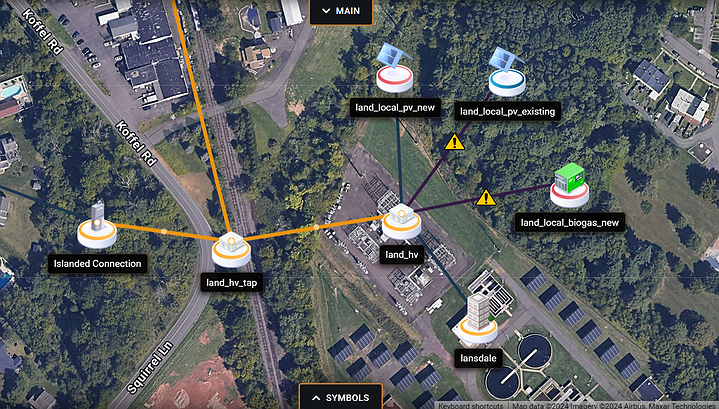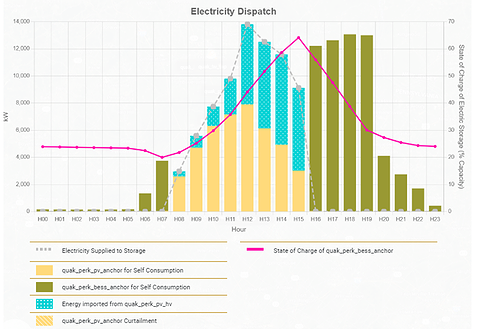An overhead view of the Southeastern Pennsylvania Resilience Corridor. After Hurricane Sandy, this area became a major focus for the city as key transportation infrastructure was in jeopardy. (Credit: https://xendee.com/insights/protogen)
Last night at Lansdale Borough Council, we received our first update on, what I believe, could be one of the most consequential discussions in Lansdale history – The Regional Resilient Corridor Project.
The Regional Resilient Corridor project is not just a proposal; it’s a forward-thinking investment that will secure our energy future, protect our residents, and position our region as a leader in sustainability and innovation.
Over the last several years, I have often written about the need to take control of our energy needs. Transmission costs are driving up the price of electricity to unseen levels and will continue to for the next several years. The easiest way for us to provide a better, cleaner, and more affordable power supply to our residents is to generate more power locally to have less power transmitted over long distances.
 One section of the corridor in Xendee's DESIGN software. The main connection terminal for the corridor runs north to south along the rail line. There is also a group of localized DER assets connected to the land_hv node to the East. This minimizes transmission losses by co-locating DER technologies with loads while also adding resilience along the corridor with the ability to transfer power in an emergency. (Credit: https://xendee.com/insights/protogen)
One section of the corridor in Xendee's DESIGN software. The main connection terminal for the corridor runs north to south along the rail line. There is also a group of localized DER assets connected to the land_hv node to the East. This minimizes transmission losses by co-locating DER technologies with loads while also adding resilience along the corridor with the ability to transfer power in an emergency. (Credit: https://xendee.com/insights/protogen)Originally, my vision was to generate as much power on our own as possible with the hope of driving down our transmission and purchasing costs as low as possible. The Regional Corridor Project takes that idea and empowers multiple electric authority municipalities to work together to find a solution to that problem.
At its core, this project connects four municipal utilities — Lansdale, Hatfield, Perkasie, and Quakertown — through a resilient electrical infrastructure designed to withstand power disruptions and support long-term economic growth.
By leveraging state-of-the-art microgrid technology and a mix of renewable energy sources, this corridor will ensure that our community remains powered even during extreme weather events and unforeseen outages.
Imagine our regional system as a specially built power network that links each community with one another using robust, weather-resistant underground cables and modern substations connected through existing SEPTA corridors.
Instead of depending on an aging, patchwork grid where a problem in one area might leave any one of us in the dark, this system creates a sort of “community backup” that can share power among the boroughs. Under normal conditions, it delivers electricity reliably and efficiently, but if a storm or outage hits one part, the other areas can help keep the lights on by isolating the problem and providing support.
Even better, by incorporating renewable energy sources like solar panels and battery storage, it not only makes our power supply more dependable but also helps reduce costs and environmental impact.
This isn’t just about keeping the lights on—it’s about building an energy-independent future. The project’s financial model demonstrates that Lansdale and its partner communities are already committed to spending hundreds of millions on electricity over the next 25 years.
Instead of paying for unpredictable energy costs, we have an opportunity to reinvest those funds into a system that we control—one that stabilizes prices, creates jobs, and generates revenue. This adaptation is critical to our long-term success and viability both as a municipal electric provider and as a community.
By integrating large-scale renewable energy sources and optimizing energy distribution, the Regional Resilient Corridor serves as a potential national model for smart, community-driven energy management. It positions Lansdale and the North Penn Area at the forefront of the clean energy transition, making us a leader in sustainable infrastructure.
Is this too ambitious? Absolutely not. While this project is in its infancy, it has been built on sound technical design, a strong funding strategy, and a shared commitment among municipalities to work together and lift each other up. With backing from federal and state programs, as well as a thoughtful phased implementation plan, this initiative is not just feasible— I believe it’s essential.
 The optimized dispatch generated by Xendee for a node on the resilience corridor affected by an outage. In this model, PV and a BESS is used onsite while the remaining load is imported from the excess provided by the Quakertown node. This removes the need for load curtailment on the affected node. (Credit: https://xendee.com/insights/protogen)
The optimized dispatch generated by Xendee for a node on the resilience corridor affected by an outage. In this model, PV and a BESS is used onsite while the remaining load is imported from the excess provided by the Quakertown node. This removes the need for load curtailment on the affected node. (Credit: https://xendee.com/insights/protogen)Lansdale has always been a community that looks ahead, that embraces innovation, and that takes bold steps to secure its future. The Regional Resilient Corridor is our next great leap forward. Not since Lansdale Electric was established has there been a project so, potentially, impactful to our future.
Again, this project is in very early stages, but by exploring this option alongside our sister communities we are not just investing in energy—we are investing in the long-term success and security of our community. There are thousands of questions between where we are today and the final development of this system, but now is the time to begin building a more resilient future for all and that process starts by actively exploring this potential solution to our very real challenge to keep us all moving forward together.
Mayor Herbert
Lansdale Borough
(Mayoral Musings is a weekly op-ed column submitted to North Penn Now, courtesy of Lansdale Borough Mayor Garry Herbert. The views expressed are his own and are not representative of North Penn Now or Lansdale Borough.)